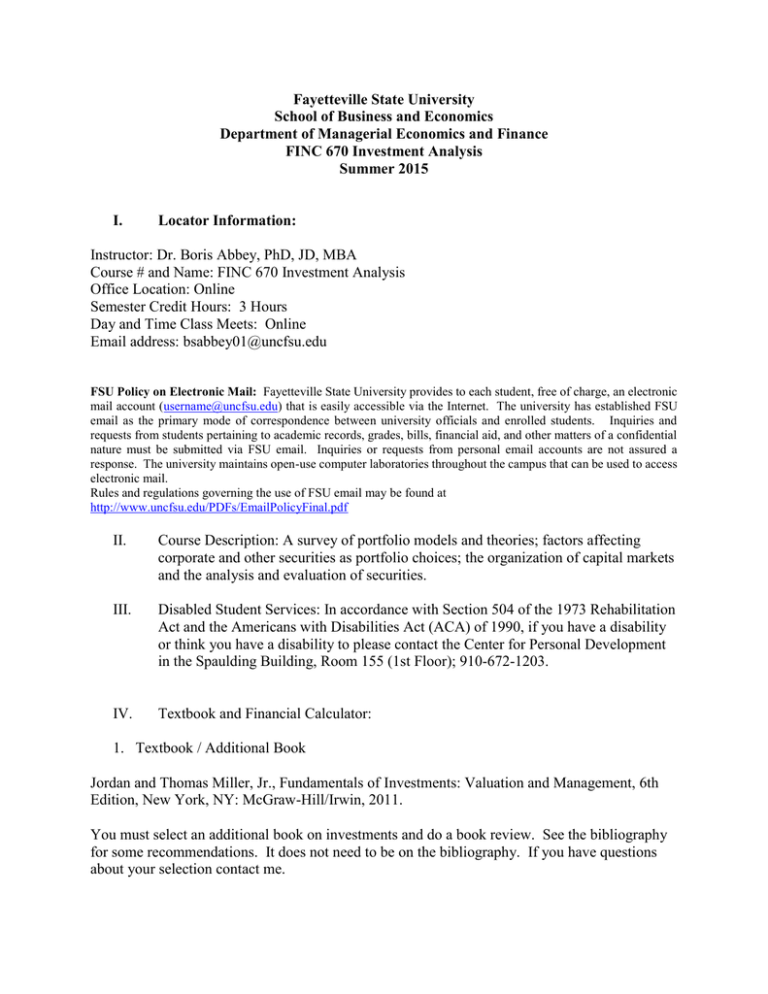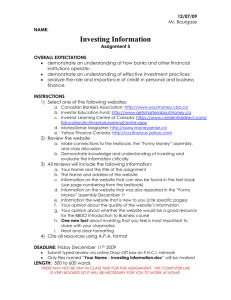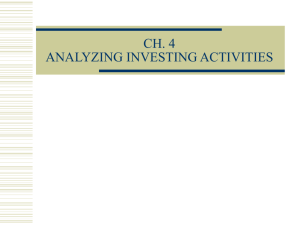
Fayetteville State University
School of Business and Economics
Department of Managerial Economics and Finance
FINC 670 Investment Analysis
Summer 2015
I.
Locator Information:
Instructor: Dr. Boris Abbey, PhD, JD, MBA
Course # and Name: FINC 670 Investment Analysis
Office Location: Online
Semester Credit Hours: 3 Hours
Day and Time Class Meets: Online
Email address: bsabbey01@uncfsu.edu
FSU Policy on Electronic Mail: Fayetteville State University provides to each student, free of charge, an electronic
mail account (username@uncfsu.edu) that is easily accessible via the Internet. The university has established FSU
email as the primary mode of correspondence between university officials and enrolled students. Inquiries and
requests from students pertaining to academic records, grades, bills, financial aid, and other matters of a confidential
nature must be submitted via FSU email. Inquiries or requests from personal email accounts are not assured a
response. The university maintains open-use computer laboratories throughout the campus that can be used to access
electronic mail.
Rules and regulations governing the use of FSU email may be found at
http://www.uncfsu.edu/PDFs/EmailPolicyFinal.pdf
II.
Course Description: A survey of portfolio models and theories; factors affecting
corporate and other securities as portfolio choices; the organization of capital markets
and the analysis and evaluation of securities.
III.
Disabled Student Services: In accordance with Section 504 of the 1973 Rehabilitation
Act and the Americans with Disabilities Act (ACA) of 1990, if you have a disability
or think you have a disability to please contact the Center for Personal Development
in the Spaulding Building, Room 155 (1st Floor); 910-672-1203.
IV.
Textbook and Financial Calculator:
1. Textbook / Additional Book
Jordan and Thomas Miller, Jr., Fundamentals of Investments: Valuation and Management, 6th
Edition, New York, NY: McGraw-Hill/Irwin, 2011.
You must select an additional book on investments and do a book review. See the bibliography
for some recommendations. It does not need to be on the bibliography. If you have questions
about your selection contact me.
2. Financial Calculator
The required calculator for the class is the Texas Instruments BA-II Plus.
I.
Student Learning Outcomes
Upon completion of this course the student should be able to:
1.
2.
3.
4.
5.
6.
Compute returns using dollar cash flows;
Use historical data to compute simple risk measures;
Relate risk to expected returns;
Demonstrate an understanding of capital market theory;
Demonstrate an understanding of behavioral financial theory;
Demonstrate a sound understanding of the institutions and mechanisms that facilitate
investment in financial assets;
7. Identify the characteristics of different types of securities;
8. Demonstrate knowledge of the characteristics of different types of derivative securities;
9. Understand how derivative securities are used as a risk management tool;
10. Demonstrate an understanding of how the market for derivatives function;
11. Value stocks using discount models;
12. Differentiate between real and nominal interest rates;
13. Understand why interest rates differ across securities and over time;
II.
Course Requirements and Evaluation Criteria
A. Grading Scale
Scores
A 90 - 100
B 80 - 89
C 70 - 79
F Below 70
B. Graded Assignments
EXAM: There will be one exam: a proctored final exam which will be cumulative. The exam is
designed to test your understanding of facts, concepts, and problem-solving methods. The exam
consists of problems and short essay questions. A clear understanding of the material is required
to do well on the exams, particularly the essay questions. The questions on each exam may
incorporate any material covered in the earlier chapters. If a student thinks that the instructor has
made a mistake in grading an exam, the student has up to one week after the exams are returned
(or graded) to students to bring the issue to the instructor’s attention.
HOMEWORK/PROJECTS: Homework or a project may be assigned for each chapter. Late
homework is not accepted and late assignments will receive a zero. All homework links and due
dates will be posted on Blackboard. It is the student’s responsibility to check Blackboard on a
frequent basis. Each week the material for the following week will be posted by Friday, 5:00
p.m. Due dates for homework are usually Fridays by 11:55 p.m. but are occasionally extended
by the professor as needed.
BOOK REVIEW: Students will prepare a review of a book on investing. The book review should
be exactly 6 pages. The first page will be a title page of the name of the book along with your
name on it. The remaining 5 pages will discuss the book and focus on what you learned from the
book. Examples of investing books are found in the bibliography at the end of the syllabus. The
book you select doesn’t need to be on that list. The due date for the book review is Friday July
24th by 11:55 p.m. A submission link will be on Blackboard. The review must be New Times
Roman font size 12 double spaced with one inch margins. Keep the format simple: Have an
introduction, the main body of the paper discussing the book, and a brief conclusion.
C. Value of Each Assignment
Points toward the final letter grade will be allocated as follows:
Final Exam (proctored)
Book Review
Homework/Projects
Total
30%
20%
50%
100%
III.
Academic Support Resources – Smarthinking, Turnitin, University College Learning
Center
IV.
Course Outline and Assignment Schedule
COURSE OUTLINE
Week 1
Week 2
Week 3
Week 4
Week 5
Chapter 15: Stock Options
BitCoin – A Good Investment?
Chapter 1: A Brief History of Risk and
Return
Chapter 2: Buying and Selling Securities
Chapter 3: Security Types
Chapter 4: Mutual Funds
Chapter 5 : Stock Markets
Chapter 6: Common Stock Valuation
Chapter 7: Stock Price Behavior and Market
Efficiency
Option Exercise
Chapter 15 Homework
Book Selection for Book
Review
Start BitCoin Research
Chapter 1 and 2 Homework
Open Trading Account
Chapter 3 and 4 Homework
Select Stocks and Trade
Chapter 5 and 6 Homework
Chapter 7 and 8 Homework
Week 6
Week 7
Week 8
V.
Chapter 8: Behavioral Finance
Chapter 9: Interest rates
Chapter 10 Bond Prices and Yields
Chapter 11: Diversification and Risky Asset
Allocation
Chapter 12: Risk Return and the SML
Chapter 13: Performance Evaluation and
Risk Management
Chapter 14: Futures Contracts
Book Review
Final Exam
Chapter 9 and 10 Homework
BitCoin Paper Due - TBD
Chapter 11 and 12
Homework
Chapter 13 and 14
Homework
Due by Friday July 24
Due by Friday July 31
Teaching Strategies
The course includes class lectures, discussion of current issues related to financial markets and
investment decisions, readings from the financial press, assigned homework problems, and
problems done in class.
VI.
Miscellaneous Items
1) It is imperative that students preview the chapters before the class during which the
material will be covered. Students are also required to read additional materials assigned
during the semester. Materials from the additional readings may be included on the
exams.
2) The instructor may change the assigned chapters or parts of chapters and, thereby, the
schedule without it having any effect on the remainder of this syllabus.
3) The mission statement of the School of Business and Economics (SBE) at Fayetteville
State University (FSU) is:
Fayetteville State University has a long tradition of providing educational access to a diverse
student population, who are seeking a relevant learning experience in the liberal arts and
professions. The School of Business and Economics builds upon the University’s strong teaching
orientation supplementing it with pedagogical and applied research. The School graduates
students who possess a sound understanding of business concepts and applications and who seek
careers in management, government, and the professional disciplines. The School also serves the
community as a catalyst for spurring economic development and assisting in economic
education.
VII.
Bibliography
The following resources might be helpful in the course. Instead of alphabetical order, they are
listed here according to the numbering system used in the class notes that are distributed to
students:
1. Seeking Alpha Transcripts Center: http://seekingalpha.com/tag/transcripts. Provides access to
searchable transcripts of earnings conference calls for a very wide range of publicly traded firms.
2. Gitman, Lawrence J., and Chad. J. Zutter, Principles of Managerial Finance, 13th Edition,
Pearson Prentice Hall (2012)
ISBN: 13: 978-0-13-255435-0
3. Chesnutt Library website http://library.uncfsu.edu/, or your local public or university library.
Two resources to look for are Value Line Investment Survey and Morningstar Investment
Research Center.
4. Ross, S., Westerfield, R., and J. Jaffe. Corporate Finance, 7th Edition, McGraw-Hill Book Co,
(2005).
5. Brealey, Richard A., Stewart C. Myers, and Franklin Allen, Principles of Corporate Finance,
2011, McGraw-Hill Irwin, New York, ISBN: 978-0-07-353073-4.
6. Damodaran, Aswath, Investment valuation : tools and techniques for determining the value of
any asset, New York: Wiley, 2002, 2nd ed.
7. Professor Aswath Damodaran’s website: www.pages.stern.nyu.edu~adamodar
8. Graham, Benjamin, The intelligent investor : a book of practical counsel, New York, N.Y. :
Harper & Row, 1985, 4th rev. ed., with a new pref. and appendix by Warren E. Buffett.
9. Cunningham, Lawrence A., (Editor) The Essays of Warren Buffett: Lessons for Corporate
America, First Revised Edition, Lawrence A. Cunningham, (2001).
10. The Scribd website has a lot of material relevant to the course. In the past I have seen the
entire texts of The Intelligent Investor and Common Stocks and Uncommon Profits posted there
for free, but I can't vouch for the legality of all postings on the site:
http://www.scribd.com/
11. Greenwald, Bruce C.N. ... [et al.], Value investing : from Graham to Buffett and beyond,
New York : Wiley, 2001.
12. Fisher, Philip A., Common stocks and uncommon profits, New York, Harper [1960], Rev.
ed. Foreword by Jeremy C. Jenks.
13. Lynch, Peter, with John Rothchild, One up on Wall Street : how to use what you already
know to make money in the market, New York, N.Y., USA : Penguin Books, 1990.
14. Greenblatt, Joel, The little book that beats the market, Hoboken, NJ. : Wiley, 2006.
15. Greenblatt, Joel, You can be a stock market genius, New York, NY. : Simon and Schuster,
1997.
16. Haugen, Robert A., The New Finance: The Case Against Efficient Markets, Prentice-Hall,
(1995).
17. The American Association of Individual Investors offers an excellent stock screener called
Stock Investor Pro. The software can be purchased at:
http://www.aaii.com/
18. Yahoo Finance: http://finance.yahoo.com/
19. SEC filings: http://www.sec.gov/idea/searchidea/companysearch_idea.html
20. Dorsey, Pat, The Little Book That Builds Wealth, Hoboken, N.J. : Wiley, 2008.
21. Kenneth French’s Data Library Website at Dartmouth:
http://mba.tuck.dartmouth.edu/pages/faculty/ken.french/data_library.html
22. Value Investing Retrospective, A Heilbrunn Center for Graham and Dodd Investing Research
Project conducted by Andrew Dubinsky, Walter Schloss Value Investing Archives. Available at:
http://www4.gsb.columbia.edu/valueinvesting/resources/articles
23. Porter, Michael, E., 1979, How Competitive Forces Shape Strategy, Harvard Business
Review, Vol. 57, Issue 2, pgs. 137-145.
24. Maubaussin, Michael J., Death, Taxes, and Reversion to the Mean, Maubaussin on Strategy,
December 14th, 2007. Available online at:
http://www.leggmason.com/individualinvestors/documents/insights/D4071Death_Taxes_and_Reversion_to_the_Mean.pdf
25. Maubaussin, Michael J., Common Errors in DCF Models, Maubaussin on Strategy, March
16th, 2006. Available online at: http://www.lmcm.com/pdf/CommonErrors.pdf
26. Google Finance:
http://www.google.com/finance
27. The Magic Formula Investing Website:
https://www.magicformulainvesting.com/marketing/servlet/forms/MFI/Marketing/forms/Welco
meForm
28. Munger, Charlie, “A Lesson on Elementary, Worldly Wisdom as it Relates to Investment
Management & Business.”, Outstanding Investor Digest, May 1995.
(You can probably find a PDF posted online if you Google for it)
29. Montier, James, The Little Book of Behavioral Investing, Hoboken, N.J. : Wiley, 2010.
30. Microsoft Money Investing Website:
http://money.msn.com/investing
To find industry and market financial ratios, search for your stock, then under "fundamentals",
click "key ratios."
31. ADVFN Website:
http://www.advfn.com/
This is the best site that I know of for efficiently cutting and pasting complete financial statement
data to Excel.
32. Miller, Merton H. and Franco Modigliani, “Dividend Policy, Growth, and the Valuation of
Shares,” The Journal of Business, Vol. 34, No. 4, pp 411-433, October, 1961.
33. Greenwald, Bruce, with Judd Kahn, Competition Demystified: A Radically Simplified
Approach to Business Strategy, London, England, Penguin Books Ltd., 2003.




